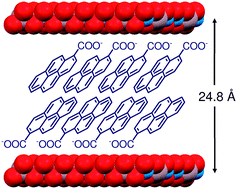Preparation and photophysical characterisation of Zn–Al layered double hydroxides intercalated by anionic pyrene derivatives†
Abstract
Zn–Al hydrotalcite-like compounds intercalated by 1,3,6,8-pyrenetetrasulfonate (PTS), 1-pyrenesulfonate (

* Corresponding authors
a
Department of Chemistry, CICECO, University of Aveiro, 3810-193 Aveiro, Portugal
E-mail:
mpillinger@ua.pt
b
Department of Chemistry, University of Coimbra, 3004-535 Coimbra, Portugal
E-mail:
sseixas@ci.uc.pt
Zn–Al hydrotalcite-like compounds intercalated by 1,3,6,8-pyrenetetrasulfonate (PTS), 1-pyrenesulfonate (

 Please wait while we load your content...
Something went wrong. Try again?
Please wait while we load your content...
Something went wrong. Try again?
S. Gago, T. Costa, J. Seixas de Melo, I. S. Gonçalves and M. Pillinger, J. Mater. Chem., 2008, 18, 894 DOI: 10.1039/B715319H
To request permission to reproduce material from this article, please go to the Copyright Clearance Center request page.
If you are an author contributing to an RSC publication, you do not need to request permission provided correct acknowledgement is given.
If you are the author of this article, you do not need to request permission to reproduce figures and diagrams provided correct acknowledgement is given. If you want to reproduce the whole article in a third-party publication (excluding your thesis/dissertation for which permission is not required) please go to the Copyright Clearance Center request page.
Read more about how to correctly acknowledge RSC content.
 Fetching data from CrossRef.
Fetching data from CrossRef.
This may take some time to load.
Loading related content
